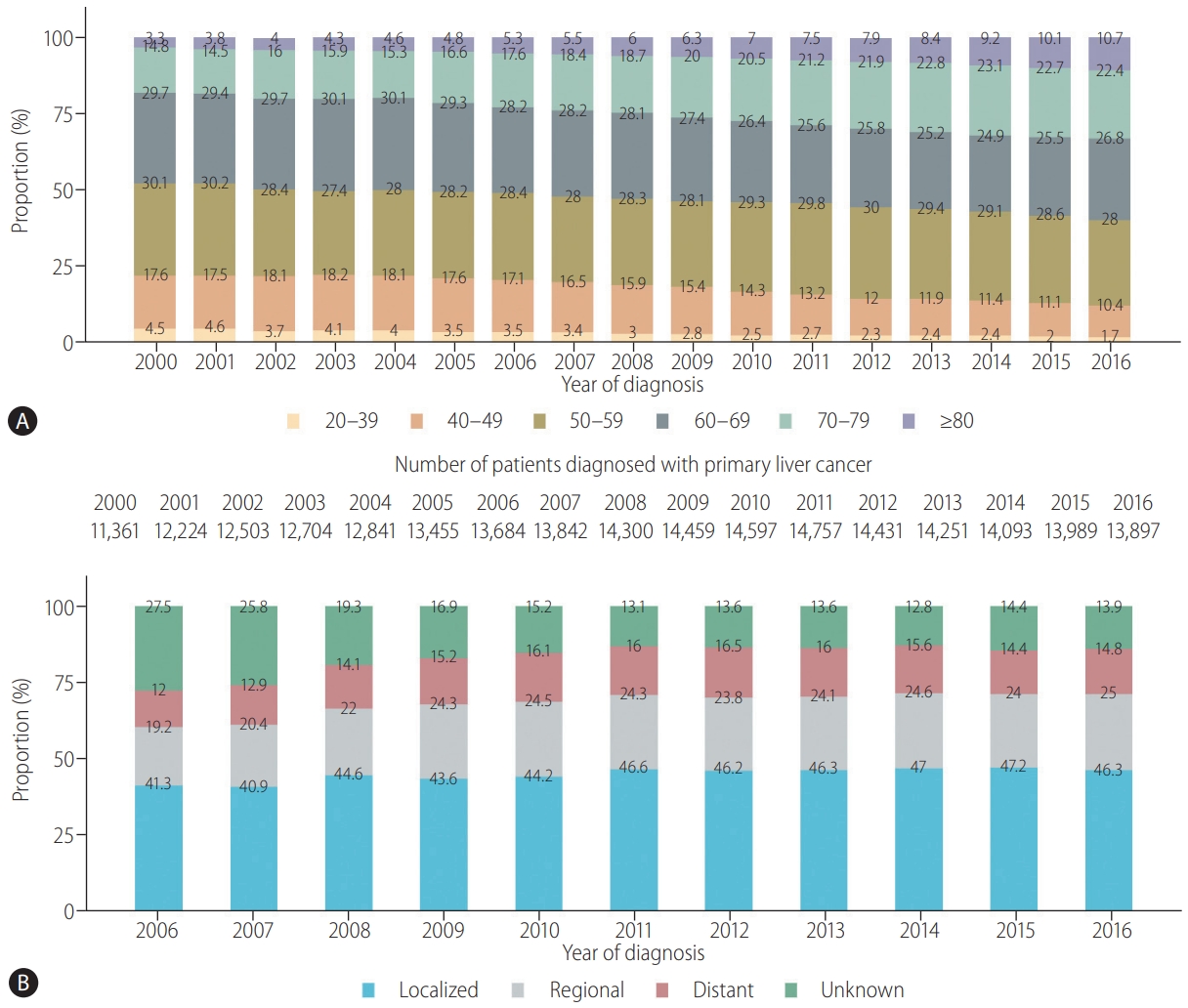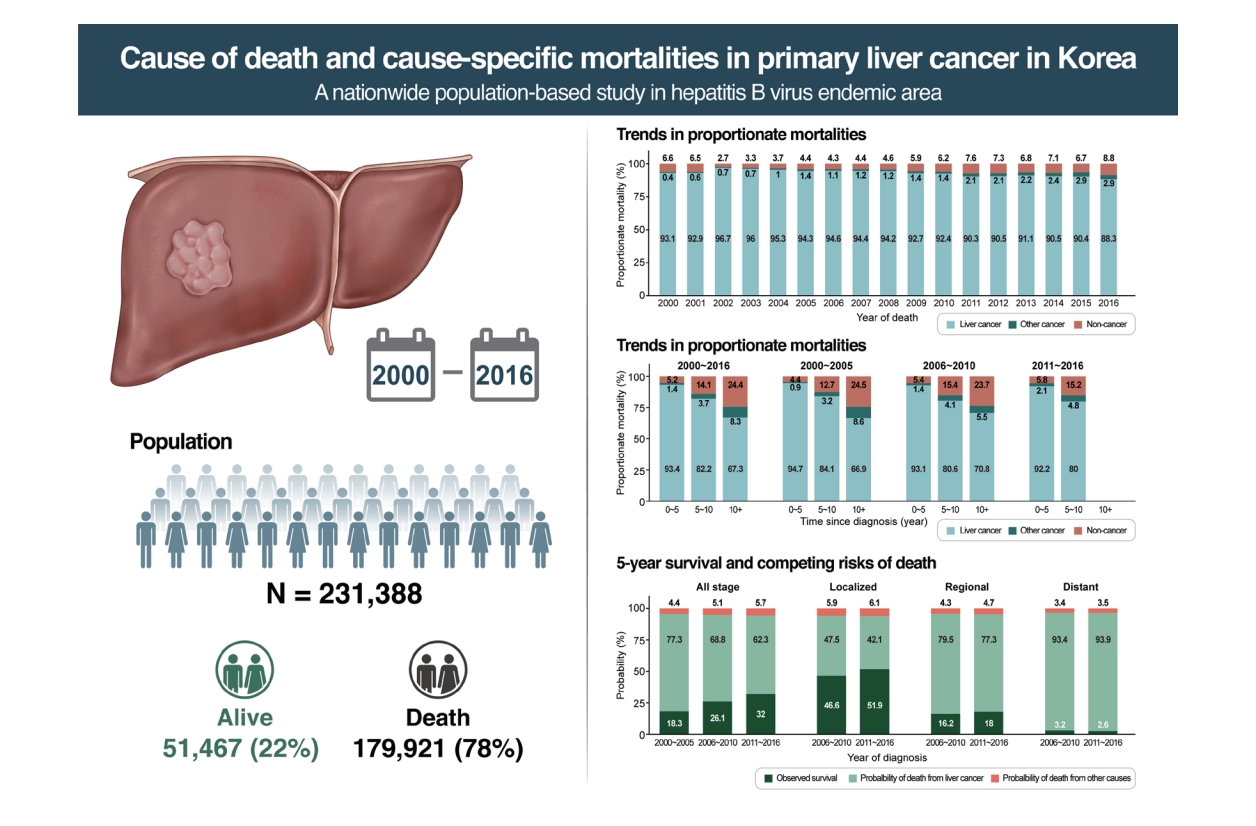| Clin Mol Hepatol > Volume 28(2); 2022 > Article |
|
ABSTRACT
Background/Aims
Methods
Results
ACKNOWLEDGMENTS
FOOTNOTES
SUPPLEMENTAL MATERIAL
Supplementary Figure 1.
Supplementary Figure 2.
Supplementary Figure 3.
Supplementary Figure 4.
Supplementary Figure 5.
Supplementary Figure 6.
Supplementary Table 1.
Supplementary Table 2.
Supplementary Table 3.
Figure 1.

Figure 2.

Figure 3.

Table 1.
| Characteristic | Total (n=231,388) | Male (n=174,638) | Female (n=56,750) |
|---|---|---|---|
| Age at diagnosis (years) | 60.9±12.1 | 59.5±11.5 | 65.4±12.5 |
| 20–39† | 7,109 (3.1) | 5,589 (3.2) | 1,520 (2.7) |
| 40–49 | 34,601 (15.0) | 29,658 (17.0) | 4,943 (8.7) |
| 50–59 | 66,578 (28.8) | 55,510 (31.8) | 11,068 (19.5) |
| 60–69 | 63,813 (27.6) | 47,588 (27.3) | 16,225 (28.6) |
| 70–79 | 44,262 (19.1) | 28,518 (16.3) | 15,744 (27.7) |
| ≥80 | 15,025 (6.5) | 7,775 (4.5) | 7,250 (12.8) |
| Alive† | 51,467 (22.2) | 38,772 (22.2) | 12,695 (22.4) |
| Death† | 179,921 (77.8) | 135,866 (77.8) | 44,055 (77.6) |
| Cause of death‡ | |||
| Liver cancer | 166,167 (92.4) | 125,530 (92.4) | 40,637 (92.2) |
| Cancer of other sites | 3,007 (1.7) | 2,136 (1.6) | 871 (2.0) |
| Non-cancer causes | 10,747 (6.0) | 8,200 (6.0) | 2,547 (5.8) |
| Tumor type‡ | |||
| HCC | 191,334 (82.7) | 150,371 (86.1) | 40,963 (72.2) |
| ICCA | 40,054 (17.3) | 24,267 (13.9) | 15,787 (27.8) |
| Tumor stage‡ | |||
| Localized | 70,244 (30.4) | 52,813 (30.2) | 17,431 (30.7) |
| Regional | 36,450 (15.8) | 28,310 (16.2) | 8,140 (14.3) |
| Distant | 23,269 (10.1) | 17,390 (10.0) | 5,879 (10.4) |
| Unknown/NA | 101,425 (43.8) | 76,125 (43.6) | 25,300 (44.6) |
Values are presented as mean±standard deviation or number (%).
HCC, hepatocellular carcinoma; ICCA, intrahepatic cholangiocarcinoma; NA, not available.
* Patients diagnosed with primary liver cancer from January 1, 2000 to December 31, 2016 who were followed up to December 31, 2017. Patients aged under 20 years at diagnosis were excluded. Tumor stage information was available only for 156,300 patients diagnosed with cancer from January 1, 2006 to December 31, 2016, among which 26,337 patients had unknown tumor stage (16.9%).
Table 2.
| Rank |
Total |
Male |
Female† |
||||||
|---|---|---|---|---|---|---|---|---|---|
| Cause of death | Count‡ | SMR§ (95% CI) | Cause of death | Count‡ | SMR§ (95% CI) | Cause of death | Count‡ | SMR§ (95% CI) | |
| 1 | Diseases of liver∥ | 3,707 (34.5) | 15.6 (15.1–16.1) | Diseases of liver∥ | 2,905 (35.4) | 9.7 (9.4–10.1) | Diseases of liver∥ | 802 (31.5) | 28.2 (26.2–30.1) |
| 2 | Viral hepatitis¶ | 1,148 (10.7) | 46.5 (43.9–49.2) | Viral hepatitis¶ | 847 (10.3) | 40.2 (37.5–42.9) | Viral hepatitis¶ | 301 (11.8) | 50.3 (44.6–56.0) |
| 3 | Cerebrovascular disease | 802 (7.5) | 0.7 (0.7–0.8) | Intentional self-harm | 656 (8.0) | 2.1 (1.9–2.2) | Cerebrovascular disease | 225 (8.8) | 0.7 (0.6–0.8) |
| 4 | Intentional self-harm | 713 (6.6) | 2.6 (2.4–2.8) | Cerebrovascular disease | 577 (7.0) | 0.6 (0.6–0.7) | Heart diseases | 202 (7.9) | 0.9 (0.8–1.0) |
| 5 | Heart diseases | 665 (6.2) | 0.8 (0.8–0.9) | Heart diseases | 463 (5.6) | 0.7 (0.6–0.7) | Diabetes mellitus | 123 (4.8) | 1.0 (0.8–1.2) |
Values are presented as number (%) unless otherwise indicated.
SMR, standard mortality ratio; CI, confidence interval.
* Patients diagnosed with primary liver cancer from January 1, 2000 to December 31, 2016 who were followed up to December 31, 2017. Patients aged under 20 years at diagnosis were excluded.
Table 3.
Abbreviations
REFERENCES
- TOOLS
-
METRICS

- ORCID iDs
-
Hyunsoon Cho

https://orcid.org/0000-0002-3261-3114 - Related articles




 PDF Links
PDF Links PubReader
PubReader ePub Link
ePub Link Full text via DOI
Full text via DOI Full text via PMC
Full text via PMC Download Citation
Download Citation Supplement1
Supplement1 Print
Print



